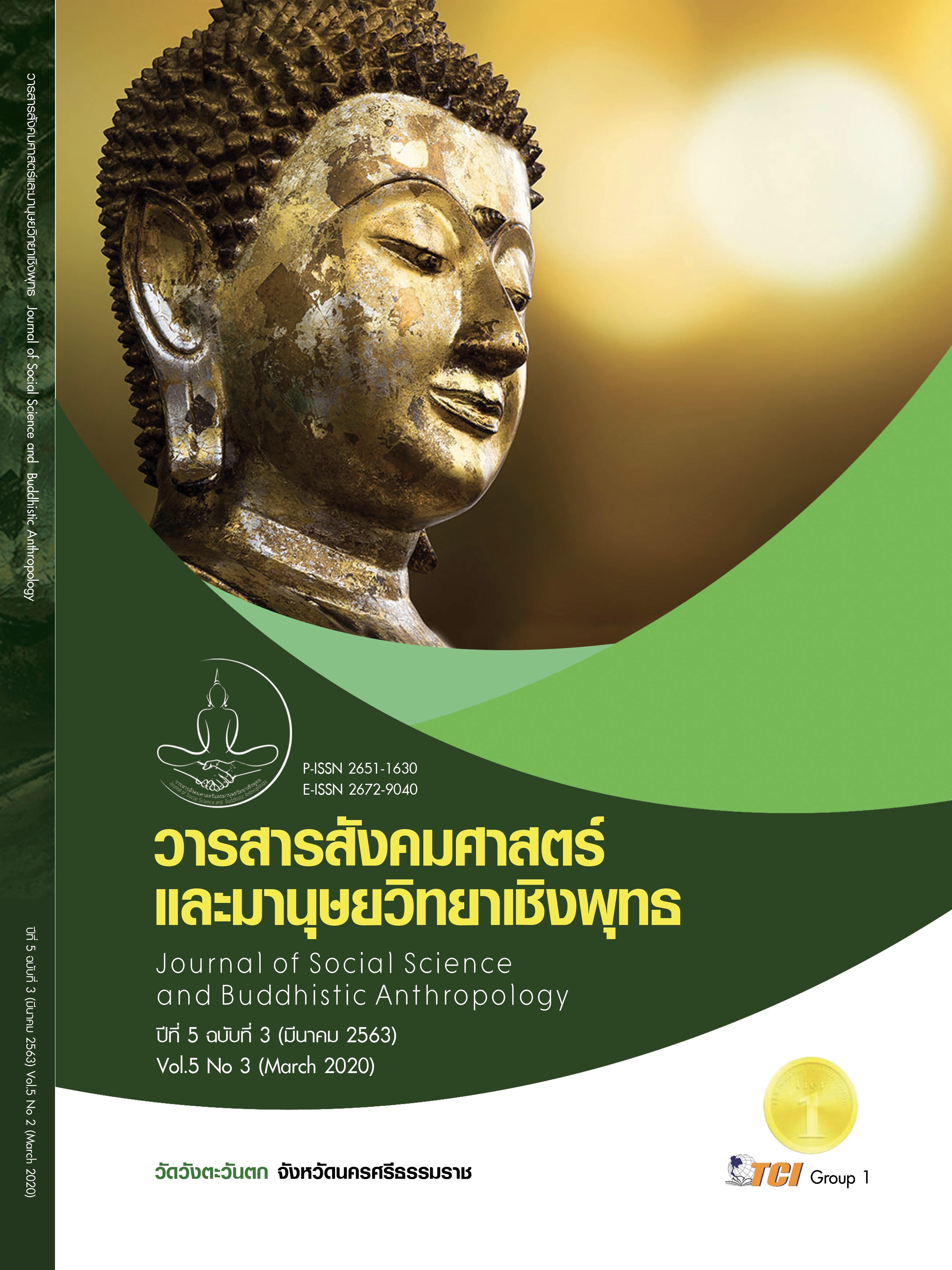A CAUSAL RELATIONSHIP MODEL OF RESPIRATORY TRACT DISEASES AMONG THAI TEXTILE AND GARMENT INDUSTRIAL FACTORIES EMPLOYEES
Keywords:
A Causal Relationship Model, Respiratory Tract Disease, Textile And Garment Industry, EmployeeAbstract
Employees in the bleaching and dyeing industry have the opportunity to experience a variety of health threats that may affect the respiratory system. The purpose of this study was to study the relationship between respiratory tract disease among textile and garment industry employees and personal factors. And environmental factors in the work, with a focus on specific studies in the textile industry, fabric dyeing and printing Research population is Employee of the dyeing and printing industry. The sample size was 220 employees who were permanent employees aged 18-60 years. The instrument used for data collection was a questionnaire about factors affecting respiratory disease. Is a survey research Analyze the structural equation model using PLS-SEM technique Smart-PLS3. The results of the research showed Personal factors related to respiratory disease were statistically significant, consisting of 6 factors. Including lung capacity, Happiness, Deep sleep, drinking, physical health status Illness and self-purchase of medication, Body mass index. The environmental factors at work consist of 2 factors which are workplace pollution and the presence of pets or animals that are carriers in the workplace. The analysis of the model to check the quality of all 8 variables found that the quality criteria meet all standard variables. Show that all cause factors are predictive related with the occurrence of respiratory diseases. The accuracy of the prognosis of the respiratory system is moderate (R2 = 0.412). The results led to guidelines for the management and employees of Industrial Dyeing. To have self-protection and the security from respiratory tract disease. It helps to know the factors causing respiratory diseases.
References
กรมควบคุมโรค กระทรวงสาธารณสุข. (2561). สถานการณ์โรคไข้หวัดใหญ่รายสัปดาห์ (สัปดาห์ที่ 39 ปี 2562ณ วันที่ 4 ตุลาคม 2562). เรียกใช้เมื่อ 15 ตุลาคม 2562 จาก https://ddc.moph.go.th/uploads/files/973120191007031852.pdf
กรมควบคุมโรคร่วมกับกรมอนามัย กระทรวงสาธารณสุข. (2552). การป้องกันอันตรายจากสารเคมีสำหรับครูและประชาชน. (พิมพ์ครั้งที่ 1). กรุงเทพมหานคร: โรงพิมพ์ชุมนุมสหกรณ์การเกษตรแห่งประเทศไทย จำกัด.
กรมควบคุมโรคร่วมกับกรมอนามัย กระทรวงสาธารณสุข. (2558). แนวทางการเฝ้าระวังพื้นที่เสี่ยงจากมลพิษทางอากาศ กรณีฝุ่นละอองขนาดเล็ก. (พิมพ์ครั้งที่ 2). กรุงเทพมหานคร: โรงพิมพ์ชุมนุมสหกรณ์การเกษตรแห่งประเทศไทย จำกัด.
ขนิษฐา เจริญลาภ และปทุมทิพย์ ปราบพาล. (2556). การกำจัดสีในน้ำเสียสิ่งทออย่างเป็นมิตรกับสิ่งแวดล้อมด้วยสารโคแอกกูแลนต์จากธรรมชาติ. ใน โครงการวิจัยทุนสนับสนุนงานวิจัยงบประมาณแผ่นดิน ปี พ.ศ. 2556 สาขาวิศวกรรมเคมี คณะวิศวกรรมศาสตร์. มหาวิทยาลัยราชมงคลกรุงเทพ.
ทศพร เอกปรีชากร และคณะ. (2559). การเปลี่ยนแปลงของสมรรถภาพปอดหลังจากทำงานในรอบวันในคนงานโรงงานผลิตเครื่องแต่งกายทหารแห่งหนึ่ง. เวชสารแพทย์ทหารบก, 69(1), 3-10.
ทิพวรรณ วงเวียน. (2557). ความรู้เกี่ยวกับการใช้ยาปฏิชีวนะในโรคติดเชื้อเฉียบพลันของระบบทางเดินหายใจส่วนบนของผู้ป่วยนอกที่เป็นโรคดังกล่าวในโรงพยาบาลสมเด็จพระบรมราชเทวี ณ ศรีราชา. วารสารเภสัชกรรมไทย, 6(2), 106-114.
นัทพงศ์ สุพิมล. (2562). สัปดาห์รณรงค์การใช้ยาปฏิชีวนะอย่างถูกต้องและสมเหตุผล. จดหมายข่าวสถาบันสุขภาพสัตว์แห่งชาติ, 18(2), 1-4.
ปภาวีย์ หมั่นกิจการ และทัศน์พงษ์ ตันติปัญจพร. (2560). ปัจจัยที่มีความสัมพันธ์กับอาการระบบทางเดินหายใจของกลุ่มผู้รับงานไปทำที่บ้าน: กรณีศึกษาแรงงานทำดอกไม้ประดิษฐ์จากสำลี อำเภอพรหมบุรี จังหวัดสิงห์บุรี. ใน ดุษฎีนิพนธ์สาธารณสุขศาสตรดุษฎีบัณฑิต สาขาสาธารณสุขศาสตร์. มหาวิทยาลัยนเรศวร.
ภูวดล ผู้เลี้ยง และคณะ. (2561). ปัจจัยเสี่ยงที่มีความสัมพันธ์กับกลุ่มอาการของระบบทางเดินหายใจของช่างเชื่อมเหล็กกล้าไร้สนิมในเขตจังหวัดระยอง. ใน วิทยานิพนธ์วิทยาศาสตรมหาบัณฑิต สาขาอาชีวอนามัยและความปลอดภัย. มหาวิทยาลัยบูรพา.
เรณุกา จรัสพงศ์พิสุทธิ์ และเกษวดี ลาภพระ. (2562). การใช้ยาปฏิชีวนะอย่างเหมาะสมสำหรับประชาชน. กรุงเทพมหานคร: ราชวิทยาลัยกุมารแพทย์แห่งประเทศไทย และสมาคมกุมารแพทย์แห่งประเทศไทย.
โรงพยาบาลบำรุงราษฎร์. (2561). มลพิษจากอนุภาคฝุ่นละออง อันตรายคุกคามในอากาศ. เรียกใช้เมื่อ 15 ตุลาคม 2561 จาก https://www.bumrungrad.com/th/health-blog/february-2018/air-pollution-threat
วัลภา บูรณกลัศ. (2560). ความสัมพันธ์ระหว่างพฤติกรรมการดูแลสุขภาพตนเอง สัมพันธภาพในครอบครัวกับความสุขของผู้สูงอายุในชุมชนแห่งหนึ่ง เขตสายไหม กรุงเทพมหานคร. วารสารพยาบาลตำรวจ, 9(2), 25-33.
ศรีสมร กมลเพ็ชร และคณะ. (2549). ปัจจัยที่สัมพันธ์กับความเสี่ยงการเกิดโรคหืดจากการทำงานของกลุ่มแรงงานนอกระบบกลุ่มผลิตภัณฑ์ผ้านวม อำเภอเมือง จังหวัดนครราชสีมา. วารสารควบคุมโรค, 32(1), 1-9.
ศิริอร สินธุ และคณะ. (2554). ปัจจัยที่สัมพันธ์กับภาวะซึมเศร้าในผู้สูงอายุที่รับการรักษา ด้วยการล้างไตทางช่องท้อง. วารสารพยาบาลศาสตร์, 29(2),84-92.
สถาบันพัฒนาอุตสาหกรรมสิ่งทอ. (2562). สถิติสิ่งทอไทยปี 2561/2562 ผลิตภัณฑ์มวลรวมภาคอุตสาหกรรม ณ ราคาปัจจุบัน. กรุงเทพมหานคร: สถาบันพัฒนาอุตสาหกรรมสิ่งทอ.
สมศักดิ์ วงค์วาร และวธู พรหมพิทยารัตน์. (2559). ผลของโปรแกรมปรับเปลี่ยนพฤติกรรมการกินยาปฏิชีวนะไม่ครบเทอมของผู้ป่วยโรคติดเชื้อระบบทางเดินหายใจ. ใน ดุษฎีนิพนธ์สาธารณสุขศาสตรดุษฎีบัณฑิต สาขาสาธารณสุขศาสตร์. มหาวิทยาลัยนเรศวร.
สำนักโรคจากการประกอบอาชีพและสิ่งแวดล้อม . (2561). คู่มือการเฝ้าระวังผลกระทบต่อสุขภาพจากปัญหาหมอกควันสำหรับบุคลากรสาธารณสุข: โรคและภัยสุขภาพจากปัญหาหมอกควัน (ฉบับปรับปรุง พ.ศ.2561). (พิมพ์ครั้งที่ 1). กรุงเทพมหานคร: สำนักพิมพ์อักษรกราฟฟิคแอนด์ดีไซน์.
Briggs DD Jr, Doherty DE. (2004). Chronic obstructive pulmonary disease: Epidemiology, pathogenesis, disease course, and prognosis. Clin Cornerstone, 6(2): S5-S16.
Donald Barclay et al. (1995). The Partial Least Squares (PLS) Approach to Causal Modelling: Personal Computer Adoption and Use as an Illustration. Technology and Investment, 2(2), 285-309.
Jim O’Neill. (2014). Antimicrobial resistance: Tackling a crisis for the health and wealth of nations. London: Wellcome trust.
Kline, R.B. (2011). Principles and Practice of Structural Equation Modeling. NewYork: Guilford Press.
Sih T. (1999). Correlation between respiratory alternations and respiratory diseases due to urban pollution. International Journal of Pediatric Otorhinolaryngology, 49(1), 261-267.








